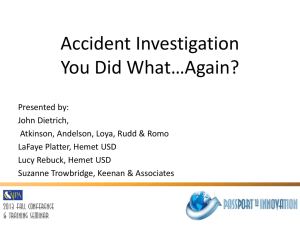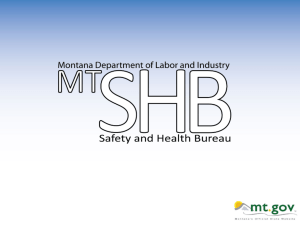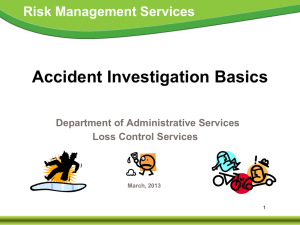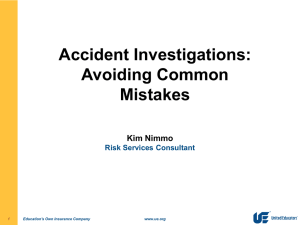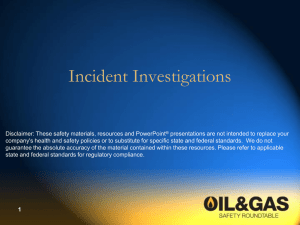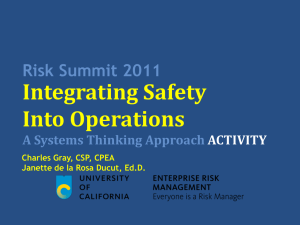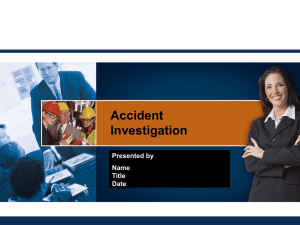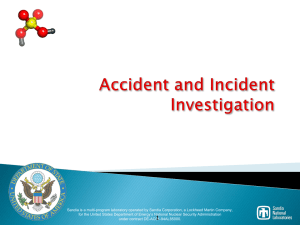Alteris-Accident-Investigation-Presentation
advertisement
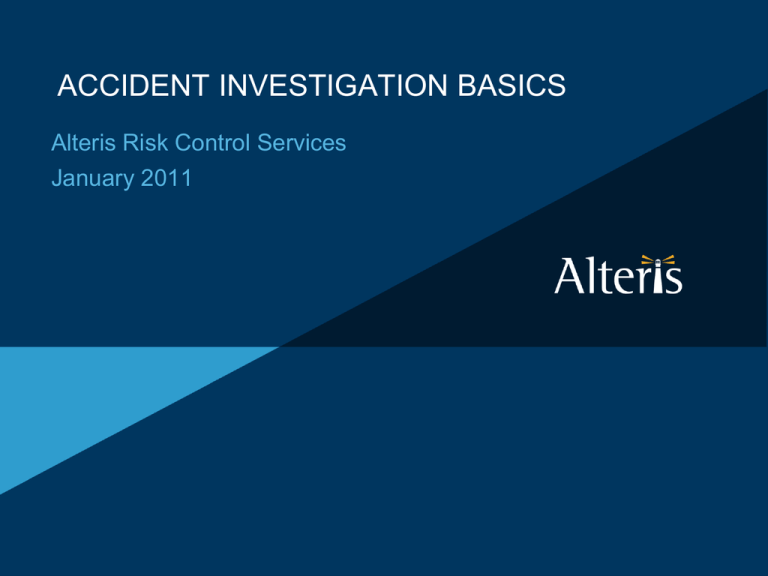
ACCIDENT INVESTIGATION BASICS Alteris Risk Control Services January 2011 WHAT YOU WILL LEARN What is an incident? What is an accident? Why should you investigate both? How should you investigate? What results are you looking for? What are you required to do for a WISHA investigation? What Is An Incident? Unplanned and unwanted event which disrupts the work process and has the potential of resulting in injury, harm, or damage to persons or property. An incident disrupts the work process, does not result in injury or damage, but should be looked as a “wake up call”. It can be thought of as the first of a series of events which could lead to a situation in which harm or damage occurs. Employers should investigate an incident to determine the root cause and use the information to stop process and behaviors that could just as easily have resulted in an accident. Example of an incident: A 50 lb carton falls off the top shelf of a 12’ high rack and lands near a worker. This event is unplanned, unwanted, and has the potential for injury. What Is An Accident? Unplanned, unwanted, but controllable event which disrupts the work process and causes injury to people. Most everyone would agree that an accident is unplanned and unwanted. The idea that an accident is controllable might be a new concept. An accident stops the normal course of events and causes property damage, or personal injury, minor or serious and occasionally results in a fatality. What Is An Accident? An accident is not “just one of those things”. Accidents are predictable and preventable events. They don’t have to happen. •Most workplace injuries and illness are not due to “accidents”. The term accident is defined as an unexpected or unintentional event, that it was “just bad luck”. More often than not it is a predictable or foreseeable “eventuality”. •By “accidents” we mean events where employees are killed, maimed, injured, or become ill from exposure to toxic chemicals or microorganisms (TB, Hepatitis, HIV, etc). •A systematic plan and follow through of investigating incidents or mishaps and altering behaviors can help stop a future accident. •Let’s take the 50 lb carton falling 12’, for the 2nd time, only this time it hits a worker, causing injury. Predictable? Yes. Preventable? Yes. Investigating why the carton fell will usually lead to solution to prevent it from falling in the future. “The Tip of the Iceberg” Accidents Accidents or injuries are the tip of the iceberg of hazards Investigate incidents since they are potential “accidents in progress” Incidents Don’t just investigate accidents. Incidents should also be reported and investigated. They were in a sense, “aborted accidents”. Criteria for investigating an incident: What is reasonably the worst outcome, equipment damage, or injury to the worker? What might the severity of the worst outcome have been? If it would have resulted in significant property loss or a serious injury, then the incident should be investigated with the same thoroughness as an actual accident investigation. The 50 pound carton falls off the top shelf of a 12’ high rack and lands near a worker. The outcome of an investigation might include correction of sloppy storage at several locations in the warehouse, unstable/heavy items will be stored at floor level if possible, refresher training of stockers on proper methods is done, supervisor begins doing daily checks. What is an “Accident”? By dictionary definition: “an unforeseen event”, “chance”, “unexpected happening”, formerly “Act of God” • From experience and analysis: they are “caused occurrences” – Predictable - the logical outcome of hazards – Preventable and avoidable - hazards do not have to exist. They are caused by things people do -- or fail to do. Fatalities Severe Injuries Minor injuries Close calls Hazardous conditions Why Investigate? Prevent future incidents (leading to accidents). Identify and eliminate hazards. Expose deficiencies in process and/or equipment. You lose money when regular work stops. Maintain worker morale. The rule requires you to investigate serious accidents. How To Investigate Develop a plan •The next 6 slides will outline each component you need for effective Accident Investigation. Then we will look into each component in more detail. •The time to develop your company’s Accident Investigation Plan is before you have an incident or an accident. •The who, when, where, what and how should be developed before the incident. •Accident Investigation Training, investigation tools and your policies and procedures should be developed before the incident or accident. •One size will not fit all. Your company’s motor vehicle investigation reports will differ from your warehouse investigations, as will your off-site investigations. How To Investigate Assemble an investigation kit • Investigate all incidents and accidents immediately • Collect facts It is important to begin your investigation immediately. Evidence disappears, the 50 lb carton of material was cleaned up and memory fades…the employee was not encouraged to report the near-miss incident and forgot about the whole thing. When investigating incidents or accidents be thorough in your capture of all available facts. You might discover that many other items were also improperly stored and that when employees were questioned there had been several other “near misses” How To Investigate Interview witnesses Interview witnesses and victims in a timely manner. LISTEN Don’t blame, don’t point out poor judgment, be sympathetic…LISTEN If you know for a fact that someone broke a rule it is not important to point that out to them at this time. Verify with them the training they have received and ask them if they know what happened to cause the accident. Again, it doesn’t do anyone any good at this juncture to be told ”it was your fault” or “you knew better” As an investigator, you will often come to the conclusion that someone engaged in an unsafe act. It is most important to determine why they engaged in an unsafe act as well as verify that they did or did not know better. How To Investigate Write a report The report should include: An accurate narrative of “what happened” Clear description of unsafe ACT or CONDITION Recommended immediate corrective action Recommended long-term corrective action Recommended follow up to assure fix is in place Recommended review to assure correction is effective. Tips for Developing A Plan Develop your action plan ahead of time. Your plan might include: • Who to notify in the workplace? • How to notify outside agencies? • Who will conduct the internal investigation? Preplanning will help you address situations timely, reducing the chance for evidence to be lost and witnesses to forget. All procedures, forms, notifications, etc. need to be listed out as step-by-step procedures. You might wish to develop a flow chart to quickly show the major components of your program. Develop a Plan Tips (continued) • What level of training is needed? • Who receives report? • Who decides what corrections will be taken and when? • Who writes report and performs follow up? Some expansion questions on the above points are: Who will be trained to investigate? Who is responsible for the finished report and what is the time frame? Who receives copies of the report? Who determines which of the recommendations will be implemented? Who is responsible for implementing the recommendations? Who goes back and assures that fixes are in place? Who assures that fixes are effective? What Should Be In The “Investigation Kit” Camera equipment First aid kit Tape recorder Gloves Tape measure Large envelopes High visibility tape Report forms Scissors Graph paper Scotch tape Sample containers with labels Personal protective equipment These are some common items for a kit. What else might be useful? Anything from your specific business or workplace that might be needed? Investigate All Incidents/Accidents Conduct and document an investigation that answers: • Who was present? • What activities were occurring? • What happened? • Where and what time? • Why did it happen? Root causes should be determined. Example: An employee gets cut. What is the cause? It is not just the saw or knife or the sharp nail. Was it a broken tool and no one reported? Did someone ignore a hazard because of lack of training, or a policy that discourages reporting? What are other examples of root causes? Enforcement failure, defective PPE, horseplay, no recognition plan, inadequate labeling. Investigate All Incidents/Accidents Also answer: • Is this a company or industry-recognized hazard? • Has the company taken previous action to control this hazard? • What are those actions? • Is this a training issue? • Sample accident investigation forms are available on our risk control website: www.argolimited.com Begin Investigations Immediately It’s crucial to collect evidence and interview witnesses as soon as possible because evidence will disappear and people will forget. How Do You Investigate? Notify individuals according to your “plan” You must involve an employee representative, the immediate supervisor, and other people with knowledge Grab your “investigation kit” Approach the scene Actions At The Accident Scene Check for danger Help the injured Secure the scene Identify and separate witnesses Gather the facts First, make sure you and others don’t become victims! Always check for stillpresent dangerous situations. Then, help the injured as necessary. Secure the scene and initiate chains of custody for physical evidence. Identify witnesses and physical evidence. Separate witnesses from one another If physical evidence is stabilized, then begin as quickly as possible with interviews. REMEMBER, BE A GOOD LISTENER. Fact Finding Witnesses and physical evidence Employees/other witnesses Position of tools and equipment Equipment operation logs, charts, records Equipment identification numbers Fact Finding Take notes on environmental conditions, air quality Take samples Note housekeeping and general working environment Note floor or surface condition Take many pictures Draw the scene Some scenes are more delicate then others. If items of physical evidence are time sensitive address those first. If items of evidence are numerous then you may need additional assistance. Some scenes will return to normal very quickly. Are you prepared to be able to recreate the scene from your documentation? Consider creating a photo log. The log should describe the date, time, give a description of what is captured in the photo and directionality. Link to sketch of accident scene. Interview Witnesses LISTEN Don’t blame, just get facts Talk to witnesses as equals Keep conversations informal Interview Witnesses Choose a private place to talk Ask open ended questions Interview promptly after the incident Ask some questions to which you know the answers Your method and outcome of interview should include: who is to be interviewed first; who is credible; who can corroborate information you know is accurate; how to ascertain the truth bases on a limitation of numbers of witnesses. Be respectful, are you the best person to conduct the interview? If the issue is highly technical consider a specialist, this may be an internal resource or it may be an outside resource. Write The Report How and why did the accident happen? • Create a list of suspected causes and human actions • Use information gathered from sketches, photographs, physical evidence, witness statements Remember that your report needs to be based on facts. All recommendations should be based on accurate documented findings of facts and all findings and recommendations should be from verifiable sources. Write The Report Answer the following in the report: When and where did the accident happen? What was the sequence of events? Who was involved? What injuries occurred or what equipment was damaged? How were the employees injured? Report Conclusions What should happen to prevent future accidents? What resources are needed? Who is responsible for making changes? • Who will follow up and insure implementation of corrections? • What will be future long-term procedures? Conclusions must always be based upon facts found during your investigation. If additional resources are needed during the implementation of recommendations, then provide options. Having a comprehensive plan in place will allow for the success of your investigation. Success of an investigation is the implementation of viable corrections and their ongoing use.

